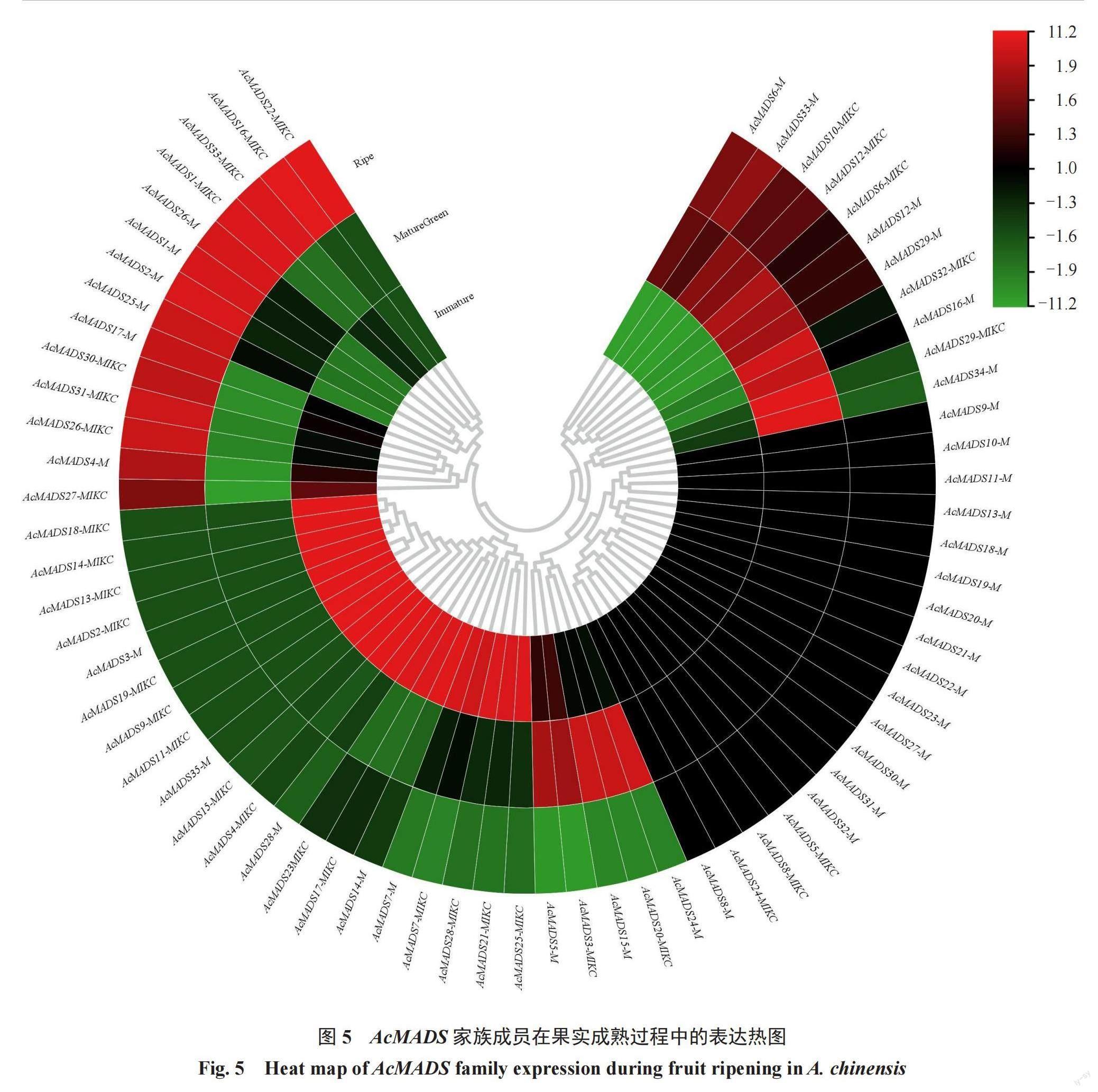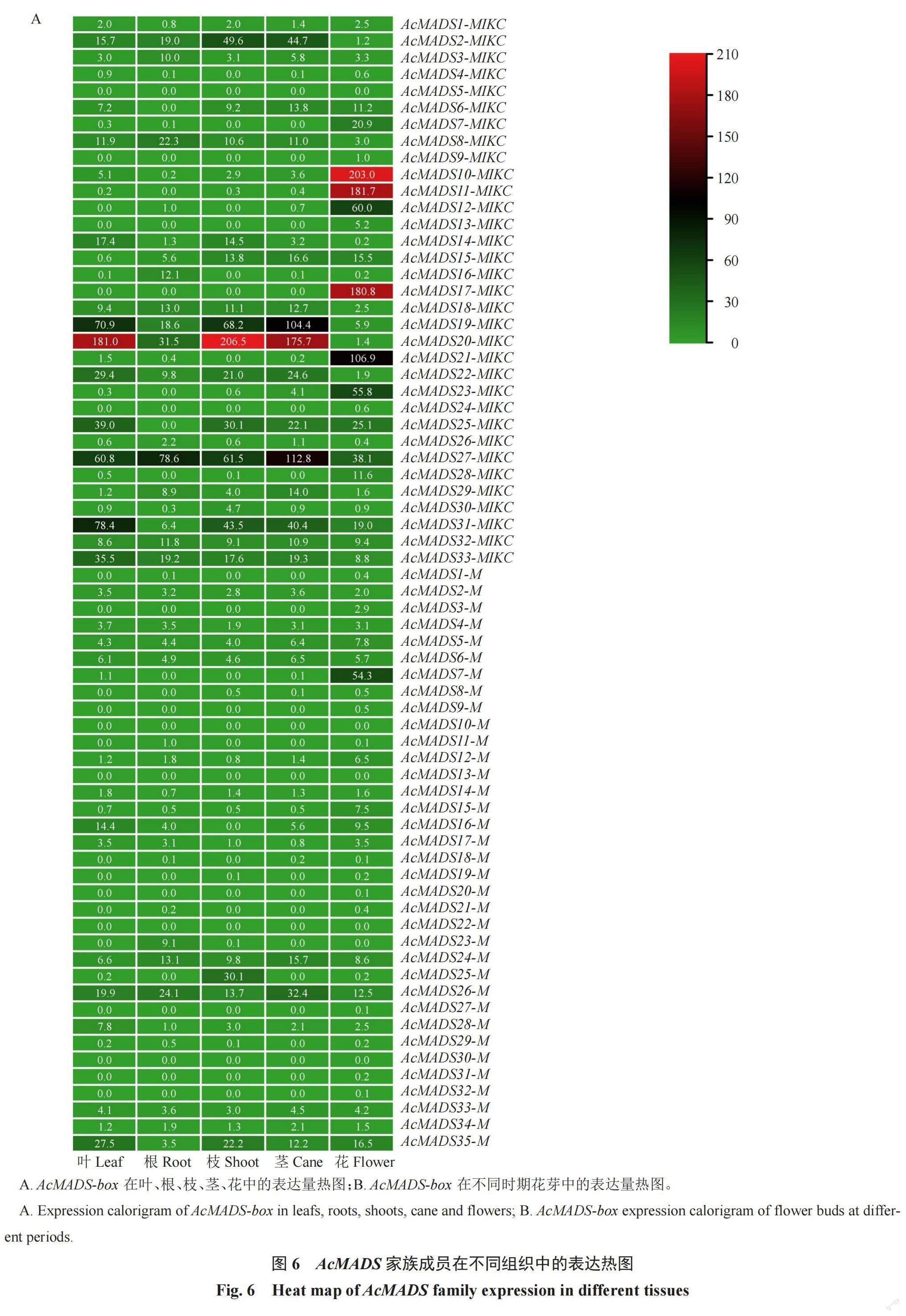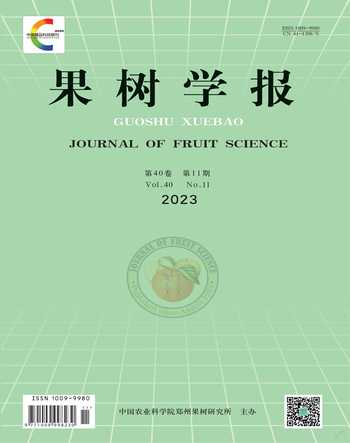中華獼猴桃全基因組MADS-box基因家族鑒定及表達分析
高歡 鄭珂昕 廖光聯 王海令 陳璐 賈東峰 黃春輝 曲雪艷 徐小彪



摘? ? 要:【目的】鑒定并分析中華獼猴桃MADS-box基因家族成員,探明MADS-box基因家族成員在果實生長發育及芽休眠中的表達模式。【方法】基于中華獼猴桃紅陽V3基因組數據庫,利用生物信息學方法對中華獼猴桃MADS-box全基因組進行鑒定,分析其家族成員的理化性質、系統進化樹、保守基序、順式作用元件,并對其在果實生長發育及不同組織中的表達模式進行分析。【結果】在中華獼猴桃紅陽基因組中鑒定到了68個AcMADS-box基因,共包含11個亞家族,不均勻地分布于22條染色體上,成員間共存在32對共線性基因對;在基因家族上游啟動子區域發現與光響應、激素響應、逆境脅迫響應等相關的順式元件;17個AcMADS-box基因在組織間高表達且有表達特異性,推測是參與調控中華獼猴桃生長發育的關鍵基因。【結論】初步鑒定并提供了AcMADS-box家族成員信息,16個AcMADS-box家族成員在根、枝、莖、葉、花中高表達,8個家族成員在花芽中高表達。結果為進一步研究AcMADS-box參與中華獼猴桃的生長發育調控機制提供參考。
關鍵詞:中華獼猴桃;MADS-box;光響應;順式元件;生長發育
中圖分類號:S663.4 文獻標志碼:A 文章編號:1009-9980(2023)11-2307-18
Genome-wide identification and expression analysis of the MADS-box gene family in Actinidia chinensis
GAO Huan1, 2, ZHENG Kexin1, 2, LIAO Guanglian2, WANG Hailing1, 2, CHEN Lu2, JIA Dongfeng1, 2, HUANG Chunhui1, 2, QU Xueyan1, 2, XU Xiaobiao1, 2*
(1College of Agronomy, Jiangxi Agricultural University, Nanchang 330045, Jiangxi, China; 2Kiwifruit Institute of Jiangxi Agricultural University, Nanchang 330045, Jiangxi, China)
Abstract: 【Objective】 MADS-box transcription factor plays an important role in plant growth and development, such as regulating abiotic stress response, transition from vegetative growth to reproductive growth, root development and fruit maturation. Members of the MADS-box gene family have been identified in several species. However, knowledge about MADS-box gene family members, and their evolutionary and functional characteristics is limited in kiwifruit. The purpose of this study was to identify and analyze MADS-box gene family and determined its expression during the fruit development and bud dormancy, so as to provide theoretical basis for the regulation mechanism of MADS-box gene family members. 【Methods】 Based on the Hongyang ‘V3 genome data of Actinidia chinensis, MADS-box was identified and its gene structure, chromosome distribution, phylogeny, promoter cis-acting element and expression patterns were analyzed. 【Results】 68 AcMADS-box genes were identified in the Hongyang genome of A. chinensis, among which 35 belonged to Type I genes and 33 belonged to Type Ⅱ genes. There were 11 subfamilies (Mγ, Mβ, Mδ, Mα, FLM, SOC1, ANR1, SVP, AP3, SHP and SEP). AcMADS-box gene was unevenly distributed on 21 chromosomes except 8, 10, 17, 18, 19, 22 and 24. There were 32 collinear gene pairs, 11, 4 and 3 pairs of MIKC, M, MIKC and M genomes, respectively. The results of the physical and chemical properties showed that the protein encoded by AcMADS-box gene family was composed of 77 to 1703 aa, the molecular weight of the protein was 8 917.01 to 121 149.91 u, and the isoelectric point was 4.55 to 11.25. Except AcMIDS24-MIKC, the protein was fat-soluble hydrophilic protein. AcMADS24-MIKC was a water-soluble hydrophilic protein. The CDS sequence length encoded by AcMADS-box protein was 234 to 1791 bp except for AcMIDS33-M, and the CDS sequence length encoded by AcMIDS33-M gene was 3222 bp, which was significantly higher than other genes of AcMADS-box gene family. In addition, the subcellular localization prediction analysis showed that the AcMADS-box gene family members were located in the nucleus. By predicting the secondary structure of the proteins encoded by 68 members of the MADS gene family, it was found that the secondary structure of the MADS gene family proteins was mainly Alpha helix, in which Type Ⅱ accounted for 45.83%-83.57% and TypeⅠaccounted for 23.75%-72.72%. Random coil of Type Ⅱ accounted for 7.14%-47.06% and TypeⅠaccounted for 16.58%-52.71%. Beta turn of Type Ⅱ accounted for 0%-8.74% and TypeⅠBeta turn accounted for 1.3%-13.1%. Extension strand of Type Ⅱ accounted 1.94%-18.13% and TypeⅠaccount for 5.88%-28.22%. The proportion of Beta turn and extension strand had little difference but was significantly lower than Alpha helix and Random coil. 12 motifs were found in AcMADS-box protein sequence named Motif 1-Motif 12 motifs. Motif 1 and Motif 2 were typical domains of MADS, and all proteins contained Motif 1 or Motif 2. Motif 4 was found in all Type Ⅱ proteins except AcMADS1-MIKC and AcMADS30-MIKC. Motif 5, Motif 7, Motif 9 and Motif 10 belonged to the specific domain of TypeⅠ. A total of 47 elements related to light response (28), hormone response (12), stress resistance (4) and growth rhythm (3) were identified in the upstream promoter region of AcMADS-box gene family. 771 components related to optical response were identified, including G-Box, Box4, GT1-motif and CTt-motif, and each AcMADS-box contained at least 5 components related to optical response. Five hormones regulated by AcMADS-box cis-acting element were ABA (ABRE), Auxin (AuxRE, AuxRR-core, TGA-box and TGA-element), MeJA (CGTCA-motif and TGACG-motif), GA3 (GARE-motif, P-box and TATC-box), and SA (SARE and TAT-element). There were stress-related elements in the gene family, including those related to drought induction (MBS), low temperature response (LTR), anaerobic induction (ARE) and stress-resistance (TC-rich repeats). In addition, the AcMADS-box gene family also contained cis-acting element related to meristem expression (CAT-box, NON-box) and circadian rhythms. Transcriptomic analysis showed that the expression of AcMADS -box genes was significantly different in fruit ripening, 18 family members (10 M type and 3 MIKC type) had no expression in the whole development stage, and 16 members of AcMADS-box family had the highest expression level in young fruit period. The expression levels of 20 family members decreased with fruit ripening, while the expression levels of 14 family members increased with fruit ripening. The expression levels of AcMADS35-M and AcMADS21-MIKC genes were the highest at the ripening period, and then decreased. The expression levels of AcMADS26-M genes were opposite to those of AcMADS35-M and AcMADS21-MIKC genes, and increased with fruit ripening. During ripening period, its expression was significantly higher than that in young fruit period and mature-green period. The expression levels of AcMADS10-MIKC, AcMADS12-MIKC and AcMADS6-MIKC were the highest in the mature-green period. The expression level of AcMADS10-MIKC gene was higher in young fruit period, mature-green period and ripening period. The analysis of AcMADS-box expression in different tissues (leaf, root, vine, cane, flower and flower bud) showed that AcMADS-box genes were differentially expressed in different tissues, and 16 family members were highly expressed in leaves, roots, vines, canes and flowers of A. chinensis. Among them, AcMADS10-MIKC, AcMADS11-MIKC, AcMADS12-MIKC, AcMADS17-MIKC, AcMADS21-MIKC, AcMADS23-MIKC and AcMADS7-M were expressed significantly higher in flowers than in other tissues. The expression level of AcMADS2-MIKC in vines and canes was higher than that in leaves, roots and flowers. The expression of AcMADS19-MIKC, AcMADS20-MIKC and AcMADS31-MIKC was significantly higher in leaves, vines and canes than in roots and flowers. Eight family members were highly expressed in the flower buds. Among them, the expression of AcMADS20-MIKC was higher in Jan., Feb., Mar., Apr., Nov. and Dec., while AcMADS26-M was significantly higher in May, Jun., Jul. and Aug. than that of the remaining 6 months. 【Conclusion】 A total of 68 AcMADS-box genes were identified in this paper. Through the sequence analysis of 2000 bp upstream promoter of AcMADS-box family members, it was found that each gene member of the family contained multiple cis-acting elements related to hormone response and stress response. It is speculated that members of this family may be involved in the regulation of fruit ripening and the resistance to stress such as drought, low temperature and anaerobic response. We found that 17 AcMADS-box genes were highly expressed and had expression specificity among tissues, which were speculated to be the key genes involved in regulating the development of the growth and development of A. chinensis.
Key words: Actinidia chinensis; MADS-box; Optical response; Cis-acting element; Growth and development
收稿日期:2023-03-22 接受日期:2023-08-03
基金項目:國家自然科學基金項目(32160692)
作者簡介:高歡,女,在讀碩士研究生,研究方向:果樹種質資源與分子生物技術。Tel:15797810980,E-mail:gh11180128@163.com
*通信作者Author for correspondence. Tel:13767008891,E-mail:xbxu@jxau.edu.cn
MADS命名源于4種蛋白因子的首字母:MINICHROMOSOME MAINTENANCE 1(MCM1)、AGAMOUS(AG)、DEFICIENS(DEF)和SERUM RESPONSE FACTOR(SRF)[1]。這些蛋白因子的共同特點是N段均含有50~60個氨基酸殘基組成的高度保守結構域—MADS結構域[2],該結構域可與靶基因調控域中CArG-box[CC(A/T)6GG]序列結合[3]。根據進化系譜,MADS主要包括Type-Ⅰ和Type-Ⅱ兩類[4]。其中Type-Ⅰ型基因的數目大,進化過程中選擇的壓力較小,常以串聯重復的方式產生新基因。而Type-Ⅱ型基因的數目大,進化過程中選擇的壓力極大,以重復的方式產生新的基因[5-7]。植物中常見的MADS-box基因為M型(Type-Ⅰ)和MIKC型(Type-Ⅱ)。早期發現MADS-box調節花器官的發育并形成了著名的ABCDE模型[8-9],揭示了MADS-box在花器官發育中的作用。在擬南芥中A類(AP1和FUL)B類(AP3和PI),主要負責花萼和花瓣的發育,在花瓣和雄蕊中特異性表達;C類(AGAMOUS),負責調控雄蕊和心皮發育;D類(AGL11),在胚珠中特異表達;E類(SEP),負責調控四輪花器官的形成[10]。近些年有關MADS-box轉錄因子的研究陸續報道,發現它們除了參與調節開花時間、影響花器官的形成和花粉育性外,還可以參與調控植物營養生長到生殖生長的轉化、參與調控植物的光合作用、種皮發育、胚形態建成、子房發育、根的生長發育,該家族基因成為果實成熟及品質形成的重要調控網絡[11]。2018年,Lu等[12]證明了FaMADS1a負調控FaPAL6、FaCHS、FaDFR和FaANS來抑制花青苷的積累;梅忠等[13]也發現,PpcDAM6還參與櫻桃花芽休眠及休眠解除過程。
目前為止已經在多個物種中進行了MADS-box基因家族成員鑒定,如擬南芥、蘋果、梨、葡萄、枇杷、蘭花[14-19]、番茄[4]等,但關于獼猴桃MADS-box基因家族的鑒定研究尚未進行。筆者基于獼猴桃數據庫紅陽獼猴桃全基因組測序結果,利用生物信息的方法對獼猴桃MADS-box轉錄因子家族成員進行鑒定,同時對其家族成員在不同組織及果實發育的不同期表達情況進行差異分析,以期為揭示MADS-box基因家族的生物學功能奠定理論基礎。
1 材料和方法
1.1 數據獲取
從獼猴桃轉錄因子數據庫PlantTFDB(http://planttfdb.gao-lab.org/index.php)下載中華獼猴桃紅陽V3基因組和基因注釋文件,從甜橙數據庫(http://citrus.Hzau.edu.cn/index.php)下載基因組蛋白序列文件,根據文獻獲得擬南芥MADS-box轉錄因子的登錄號[14],并從TAIR網站(http://www.arabidopsis.org/)下載擬南芥MADS-box轉錄因子共107個基因編碼蛋白序列。
1.2 AcMADS-box基因家族成員的全基因組鑒定
利用TBtools[20]軟件將已知的擬南芥MADS基因蛋白序列與紅陽和甜橙的基因組蛋白序列進行BLAST比對,利用Microsoft Excel 2019刪除重復序列分別獲得AcMADS-M、AcMADS-MIKC基因家族的候選序列。結合pfam(http://pfam.xfam.org/)在線網站篩選獲得候選基因序列是否具有MADS-box的保守序列,同時根據其是否具有K-box結構域將其劃分為MIKC型MADS-box基因和M型MADS-box基因成員。同樣的方法篩選CsMADS-box基因家族成員。
1.3 AcMADS-box基因家族系統發育樹構建
分別從甜橙數據庫和獼猴桃數據庫下載甜橙和中華獼猴桃紅陽的MADS-box基因家族成員的氨基酸序列。利用MEGA X軟件先將擬南芥、獼猴桃及甜橙的MADS-box編碼的氨基酸序列進行多重序列比對,然后用鄰接法構建進化樹,軟件參數設置默認值。
1.4 AcMADS-box基因家族的理化性質分析
利用中華獼猴桃紅陽V3基因組的注釋文件用TBtools[20]軟件提取染色體定位信息。利用ExPASy(https://web.expasy.org/protparam/)在線網站預測CsMADS基因蛋白質分子質量大小、等電點和疏水性等信息[21]。用Plant-mPLoc(http://www.csbio.sjtu.edu.cn/bioinf/plant-multi/)在線網站來預測AcMADS的亞細胞定位。
1.5 AcMADS-box蛋白二級結構預測與保守域分析
使用NPSA(https://npsa-prabi.ibcp.fr/cgibin/npsa_automat.pl?page=npsa_sopma.html)在線網站對AcMADS-box基因家族成員的蛋白質二級結構進行分析。利用MEME(http://meme-suite.org/tools/meme)在線網站對AcMADS-box蛋白的motifs進行識別,motifs的最大值設為12[22],然后利用TBtools[20]軟件進行可視化分析。
1.6 AcMADS-box基因家族成員順式作用元件及共線性分析
利用TBtools[20]軟件提取AcMADS-box基因翻譯起始位點上游2000 bp,然后利用PlantCARE(http://bioinformatics.psb.ugent.be/webtools/plantcare/html/)在線網站進行順式作用元件分析[23],利用Microsoft Excel 2019對結果進行統計分析,用TBtools[20]軟件繪制熱圖。利用TBtools[20]對MADS家族基因進行共線性分析。
1.7 AcMADS-box基因家族在果實發育期的表達分析
從獼猴桃數據庫(https://kiwifruitgenome.org/organism/3)下載中華獼猴桃紅陽V3在幼果期(immature)、綠熟期(mature green)、軟熟期(ripe)3個時期的轉錄組數據,同時從NCBI下載PRJNA888809轉錄組測序數據,采用RPKM法計算基因表達量,利用TBtools[20]進行log2標準化后生成熱圖。
2 結果與分析
2.1 AcMADS-box基因家族成員
鑒定出中華獼猴桃MADS-box基因家族成員68個,其中M型AcMADS-box基因有35個,命名為AcMADS1-M~AcMADS35-M,MIKC型AcMADS-box基因33個,命名為AcMADS1-MIKC~AcMADS33-MIKC(表1),ACMADS-box基因不均勻的分布在除8、10、17、18、19、22、24號以外的22條染色體上,其中MIKC型家族基因在15號染色體上分布最多。M型家族基因在2、12號染色體上分布最多。除AcMIDS33-M外AcMADS-box蛋白編碼CDS序列長度為234(AcMIDS23-M)~1791(AcMIDS24-M)bp,AcMIDS33-M基因CDS序列長度為3222 bp,顯著高于AcMADS-box基因家族成員的其他基因。另外所有AcMADS-box基因家族成員均為預測定位于細胞核。
2.2 AcMADS-box基因家族的理化性質
利用ExPASY在線網站對AcMADS-box蛋白的理化性質進行分析,結果如表2所示,AcMADS-box基因家族編碼蛋白由77~1703個氨基酸組成,蛋白質分子質量大小為8 917.01~121 149.91 u,等電點為4.55~11.25。此外,除AcMIDS24-MIKC外AcMADS-box蛋白均為脂溶性親水蛋白,AcMADS24-MIKC為水溶性親水蛋白;94%的MIKC型AcMADS-box蛋白和71%的M型為不穩定性蛋白。
2.3 AcMADS-box蛋白結構預測及保守域
利用NPSA在線軟件對68個MADS基因家族成員編碼的蛋白質進行二級結構預測,結果如表3所示,中華獼猴桃MADS基因家族蛋白二級結構主要是α螺旋(Alpha helix),其中Type Ⅱ型占比45.83%(AcMADS1-MIKC)~83.57%(AcMADS24-MIKC),Type Ⅰ型占比23.75%(AcADS35-M)~72.72%(AcADS12-M);不規則卷曲(Random coil)Type Ⅱ型占比7.14%(AcMADS24-MIKC)~47.06%(AcMADS14-MIKC),Type Ⅰ型占比16.58%(AcADS12-M)~52.71%(AcADS34-M)。Type Ⅱ型β轉角(Beta turn)占比0%(AcMADS14-MIKC、AcMADS 18-MIKC、AcMADS 28-MIKC)~8.74%(AcMADS 17-MIKC),Type Ⅰ型β轉角(Beta turn)占比1.30%(AcADS23-M)~13.10%(AcADS8-M);Type Ⅱ型延伸鏈(Extenden strand)占比1.94%(AcMADS18-MIKC)~18.13%( AcMADS 13-MIKC),Type Ⅰ型延伸鏈(Extenden strand)占比5.88%(AcADS12-M)~28.22%(AcADS13-M);β轉角與延伸鏈所占比例相差不大但顯著低于α螺旋與不規則卷曲占比。
如圖1所示,通過MEME在線軟件對AcMADS-box蛋白質序列進行分析,將基序數量設置為12個保守基序,分別為Motif1~Motif12。Motif1和Motif2是典型的MADS結構域,所有蛋白都含有Motif1或Motif2。除AcMADS1-MIKC、AcMADS30-MIKC蛋白外,Type Ⅱ型蛋白都有Motif4。Motif5、Motif7、Motif9、Motif10屬于Type Ⅰ型特有結構域。
2.4 AcMADS-box基因家族的進化
如圖2所示,擬南芥、甜橙、中華獼猴桃的MADS基因分為11個亞家族:Mγ、Mβ、Mδ、Mα、FLM、SOC1、ANR1、SVP、AP3、SHP、SEP。M型家族成員主要分布在Mα亞家族,該家族由16個M型家族成員組成。MIKC型家族成員不均勻地分布在8個亞家族,猜測可能與其功能多樣性有關。以上分析表明,AcMADS-box家族成員進化存在差異,也預示著該家族蛋白功能具有多樣性。
2.5 AMADS-box基因家族順式作用元件、多重共線性分析
利用PlantCARE在線軟件預測AcMADS-box基因家族成員上游2000 bp序列,在AcMADS-box中共鑒定出47種與光響應(28種)、激素響應(12種)、抵御逆境脅迫響應(4種)及生長節律(3種)相關的元件(圖3)。AcMADS-box中鑒定出771個與光響應相關的元件主要有G-Box、Box4、GT1-motif、TCT-motif,其中G-Box和Box4最多且在每個AcMADS-box中都至少含有5個與光響應相關的元件。AcMADS-box順式元件調控5種激素分別為ABA(ABRE)、Auxin(AuxRE、AuxRR-core、TGA-box、TGA-element)、MeJA(CGTCA-motif、TGACG-motif)、GA3(GARE-motif、P-box、TATC-box)、SA(SARE、TAT-element)。基因家族中有與逆境脅迫相關的元件,包括與干旱誘導(MBS)、低溫反應(LTR)、厭氧誘導(ARE)、抵御逆境脅迫(TC-rich repeats)相關的元件。除此之外AcMADS-box基因家族中還含有與分生組織表達(CAT-box、NON-box)、晝夜節律(Circadian)相關的順式元件。
利用TBtools軟件對中華獼猴桃MADS-box基因家族成員進行物種內共線性分析,共檢測出32對片段重復事件,如圖4所示。MIKC型、M型、MIKC和M型基因組之間分別有11對(AcMADS2-MIKC/AcMADS22-MIKC,AcMADS13-MIKC/AcMADS9-MIKC,AcMADS27-MIKC/AcMADS15-MIKC,AcMADS16-MIKC/AcMADS3-MIKC,AcMADS32-MIKC/AcMADS29-MIKC,AcMADS33-MIKC/AcMADS31-MIKC,AcMADS33-MIKC/AcMADS20-MIKC,AcMADS20-MIKC/AcMADS14-MIKC,AcMADS17-MIKC/AcMADS11-MIKC,AcMADS17-MIKC/AcMADS4-MIKC,AcMADS11-MIKC/AcMADS4-MIK),4對(AcMADS22-M/AcMADS18-M,AcMADS34-M/AcMADS31-M,AcMADS34-M/AcMADS27-M,AcMADS25-M/AcMADS1-M),3對(AcMADS16-MIKC/AcMADS32-MIK,AcMADS7-M/AcMADS21-MIKC,AcMADS23-M/AcMADS3-MIKC)重復基因,有部分基因聚集在染色體的特定區域,這可能與基因重復有關。結果表明,基因復制可能是中華獼猴桃基因組MADS基因擴增、進化的動力。
2.6 AcMADS-box基因家族成員在不同發育期的表達
對中華獼猴桃幼果期、綠熟期、軟熟期三個時期的轉錄組表達進行分析,結果如圖5所示。AcMADS基因在不同發育期的表達具有差異性,18個家族成員(M型15個、MIKC型3個)在整個發育期均無表達,16個AcMADS-box家族成員在綠熟期的表達量最高。20個家族成員基因隨著果實成熟表達量下降,14個家族成員表達量相反隨著果實的成熟表達量升高。AcMADS35-M、AcMADS21-MIKC基因在幼果期表達量最高,隨后表達量降低,AcMADS26-M基因的表達量與AcMADS35-M、AcMADS21-MIKC基因相反,隨果實的成熟表達量增加,在軟熟期其表達量顯著高于幼果期和綠熟期。AcMADS10-MIKC、AcMADS12-MIKC、AcMADS6-MIKC在綠熟期表達量最高,其中AcMADS10-MIKC基因在幼果期、綠熟期、軟熟期三時期的表達量都較高。
2.7 AcMADS-box基因家族成員在不同組織的表達
為了研究AcMADS-box基因家族的表達模式,分別對AcMADS-box在不同組織(葉、根、枝、莖、花、芽)的表達量進行分析,結果如圖6所示。AcMADS-box基因在不同組織中有差異的表達,16個家族成員(AcMADS2-MIKC,AcMADS10-MIKC,AcMADS11-MIKC,AcMADS12-MIKC,AcMADS17-MIKC,AcMADS19-MIKC,AcMADS20-MIKC,AcMADS21-MIKC,AcMADS23-MIKC,AcMADS27-MIKC,AcMADS31-MIKC,AcMADS33-MIKC,AcMADS7-M,AcMADS25-M,AcMADS26-M,AcMADS35-M)在中華獼猴桃葉、根、枝、莖、花中高表達(圖6-A)。其中AcMADS10-MIKC、AcMADS11-MIKC、AcMADS12-MIKC、AcMADS17-MIKC、AcMADS21-MIKC、AcMADS23-MIKC、AcMADS7-M在花中表達量顯著高于其他組織;AcMADS2-MIKC在枝、莖中的表達量高于葉、根、花;AcMADS19-MIKC、AcMADS20-MIKC、AcMADS31-MIKC在葉、枝、莖中的表達量顯著高于在根花中的表達量。
8個家族成員(AcMADS2-MIKC,AcMADS19-MIKC,AcMADS20-MIKC,AcMADS22-MIKC,AcMADS27-MIKC,AcMADS31-MIKC,AcMADS33-MIKC,AcMADS26-M)在花芽中高表達(圖6-B)。其中AcMADS20-MIKC在1、2、3、4、11、12月表達量高于5、6、7、8月表達量,而AcMADS26-M在5、6、7、8月表達量顯著高于其余6個月。
3 討 論
MADS-box是調控果樹花器官發育、果實成熟及果品發育調節網絡中的關鍵因子,是呼吸躍變型果實成熟所必需的。筆者在本研究中通過鑒定和分析AcMADS-box基因家族成員,探究該家族基因對中華獼猴桃生長發育的影響。
目前,從擬南芥[14]、蘋果[15]、梨[16]、葡萄[17]、枇杷[18]、大豆[24]等物種分別鑒定出107、146、95、54、89、143個MADS-box基因家族成員,筆者在本研究中利用生物信息分析的方法從獼猴桃紅陽數據庫獲得68個MADS-box轉錄因子,推測其數量差異可能受基因組大小或物種進化過程的缺失和復制的影響。M型MADS家族基因數量高于MIKC型,這與前人在葡萄[17]上的研究結果不一致。進化分析與保守域分析的結果一致,具有相同保守域的基因家族成員優先聚為一類,其進化樹的分類結構與擬南芥和甜橙基本一致,說明MADS基因家族在物種間具有相對保守的進化趨勢。對啟動子順式作用元件進行分析,可能對某一基因功能的研究具有重要意義。通過對AcMADS-box家族成員啟動子上游2000 bp的序列分析,發現家族各基因成員含有多個與激素反應、脅迫反應等相關的順式作用元件,推測該家族成員可能參與了果實成熟的調控和抵御干旱、低溫、厭氧等逆境脅迫。除此之外,AcMADS-box家族成員每個基因都至少含有5個與光響應相關的順式元件,推測AcMADS-box的表達量受光的調控。在錐栗[25]、葡萄[17]、枇杷[18]的啟動子中也發現了光響應、激素反應及逆境脅迫等相關的響應元件。
筆者在本研究中發現,AcMADS-box基因在不同組織及果實發育的不同時期表現出不同的表達特征,基因的表達特征與其功能密切相關,推測AcMADS-box在組織發育和植物生長過程中具有不同作用。擬南芥中的SVP/AGL24類MADS-box基因與休眠轉變密切相關,在休眠誘導期間表達量上調,休眠解除期間下調[26],目前已經在杏[27]、桃[26]、蘋果[28]、梨[29]中有相關報道。在本研究中,屬于SVP分支的AcMADS20-MIKC基因1、2、3、4、11、12月在花芽中高表達;5、6、7、8月表達量較低,與擬南芥FLC聚集的基因AcMADS26-M表達量與其相反,Hemming等[30]研究發現,FLC不僅參與擬南芥開花應答的溫度調控,而且還能夠調控多年生木本植物的芽休眠。FLC在休眠誘導期間表達上調,休眠解除后表達下調[31],在本研究中,AcMADS26-M在5、6、7、8月(休眠期)上調,1、2、3、4、11、12月表達量顯著低于5、6、7、8月,這與前人的研究結果一致,推測AcMADS20-MIKC、AcMADS26-M是調控芽休眠及休眠解除關鍵基因。筆者在本研究中還發現,在中華獼猴桃植物組織中MIKC型表達量顯著高于M型,其中屬于AP3/PI、SHP、SEP分支的AcMADS10-MIKC、AcMADS11-MIKC、AcMADS12-MIKC、AcMADS17-MIKC、AcMADS21-MIKC、AcMADS23-MIKC、AcMADS27-MIKC、AcMADS31-MIKC在花中的表達量最高;SOC1、SVP分支中AcMADS19-MIKC、AcMADS20-MIKC在葉、枝、莖的表達量高于花。
在果實成熟過程中有6個基因表達量高且有明顯差異,其中AcMADS21-MIKC屬于SEP亞家族成員,在草莓[12]、甜櫻桃[32]、蘋果[15]、枇杷[18]的研究中發現SEP亞家族基因對呼吸躍變型和非呼吸躍變型的果實有負調控作用,可以抑制乙烯的生物合成及信號傳導影響果實成熟和軟化。AcMADS21-MIKC基因轉錄本在果實中積累,且積累量隨著果實的成熟逐漸減少,這與Gaffe等[33]的研究結果相同。AcMADS26-M基因表達量與AcMADS21-MIKC、AcMADS35-M呈相反趨勢,隨著果實成熟表達量上調,筆者推測該基因可能是乙烯合成積累的促進因子。MADS家族基因的SHP亞家族基因成員在胚珠、心皮及發育中的果皮表達,可以控制類胡蘿卜素的形成。Vrebalov等[34]在番茄中發現該家族基因在早期發育及果實成熟中均發揮作用。本研究中屬于SHP亞家族的AcMADS12-MIKC基因在果實成熟期間先上升后下降,因此推測該基因的差異表達可能是促進果實成熟及類胡蘿卜素形成的關鍵。
目前有關中華獼猴桃MADS基因家族成員的信息還沒有報道,筆者分析中華獼猴桃MADS基因家族成員,推測該家族成員不僅參與中華獼猴桃花芽萌發還參與調控營養和繁殖型器官的生長發育,以期為今后關于MADS基因家族的研究和品種選育提供理論參考。
4 結 論
從中華獼猴桃紅陽V3基因組中鑒定得到了68個AcMADS-box基因(M型35個,MIKC型33個),均位于細胞核且不均勻地分布于22條染色體上。在啟動子區域發現有與光響應、激素響應、逆境脅迫等相關的順式元件。果實成熟過程中有6個AcMADS-box基因表達量高且有明顯差異,17個AcMADS-box基因在葉、根、枝、莖、花、芽組織中有差異性高表達。表明AcMADS-box在中華獼猴桃生長發育過程中有重要的調控作用。
參考文獻 References:
[1] ALVAREZ-BUYLLA E R,LILJEGREN S J,PELAZ S,GOLD S E,BURGEFF C,DITTA G S,VERGARA-SILVA F,YANOFSKY M F. MADS-box gene evolution beyond flowers:Expression in pollen,endosperm,guard cells,roots and trichomes[J]. The Plant Journal,2000,24(4):457-466.
[2] SHORE P,SHARROCKS A D. The MADS-box family of transcription factors[J]. European Journal of Biochemistry,1995,229(1):1-13.
[3] RIECHMANN J L,WANG M Q,MEYEROWITZ E M. DNA-binding properties of Arabidopsis MADS domain homeotic proteins APETALA1,APETALA3,PISTILLATA and AGAMOUS[J]. Nucleic Acids Research,1996,24(16):3134-3141.
[4] WANG Y S,ZHANG J L,HU Z L,GUO X H,TIAN S B,CHEN G P. Genome-wide analysis of the MADS-box transcription factor family in Solanum lycopersicum[J]. International Journal of Molecular Sciences,2019,20(12):2961.
[5] PAUL P,DHATT B K,MILLER M,FOLSOM J J,WANG Z,KRASSOVSKAYA I,LIU K,SANDHU J,YU H H,ZHANG C,OBATA T,STASWICK P,WALIA H. MADS78 and MADS79 are essential regulators of early seed development in rice[J]. Plant Physiology,2020,182(2):933-948.
[6] KANG I H,STEFFEN J G,PORTEREIKO M F,LLOYD A,DREWS G N. The AGL62 MADS domain protein regulates cellularization during endosperm development in Arabidopsis[J]. The Plant Cell,2008,20(3):635-647.
[7] 呂山花,孟征. MADS-box基因家族基因重復及其功能的多樣性[J]. 植物學通報,2007,42(1):60-70.
L? Shanhua,MENG Zheng. Gene duplication and functional diversification in the MADS-box gene family[J]. Chinese Bulletin of Botany,2007,42(1):60-70.
[8] COEN E S,MEYEROWITZ E M. The war of the whorls:Genetic interactions controlling flower development[J]. Nature,1991,353(6339):31-37.
[9] PELAZ S,DITTA G S,BAUMANN E,WISMAN E,YANOFSKY M F. B and C floral organ identity functions require SEPALLATA MADS-box genes[J]. Nature,2000,405(6783):200-203.
[10] SOLTIS D E,MA H,FROHLICH M W,SOLTIS P S,ALBERT V A,OPPENHEIMER D G,ALTMAN N S,DEPAMPHILIS C,LEEBENS-MACK J. The floral genome:an evolutionary history of gene duplication and shifting patterns of gene expression[J]. Trends in Plant Science,2007,12(8):358-367.
[11] 蘆旺,席萬鵬. MADS-box轉錄因子在果實成熟及品質形成中的調控作用研究進展[J]. 園藝學報,2018,45(9):1802-1812.
LU Wang,XI Wanpeng. MADS-box transcription factors are involved in regulation for fruit ripening and quality development[J]. Acta Horticulturae Sinica,2018,45(9):1802-1812.
[12] LU W J,CHEN J X,REN X C,YUAN J J,HAN X Y,MAO L C,YING T J,LUO Z S. One novel strawberry MADS-box transcription factor FaMADS1a acts as a negative regulator in fruit ripening[J]. Scientia Horticulturae,2018,227:124-131.
[13] 梅忠,朱友銀,劉向蕾,李永強,趙華. 中國櫻桃花芽休眠相關MADS-box基因的克隆與功能初探[J]. 植物生理學報,2018,54(9):1433-1440.
MEI Zhong,ZHU Youyin,LIU Xianglei,LI Yongqiang,ZHAO Hua. Isolation and functional analysis of dormancy-associated MADS-box gene in cherry (Prunus pseudocerasus) flower bud[J]. Plant Physiology Journal,2018,54(9):1433-1440.
[14] PARENICOV? L,DE FOLTER S,KIEFFER M,HORNER D S,FAVALLI C,BUSSCHER J,COOK H E,INGRAM R M,KATER M M,DAVIES B,ANGENENT G C,COLOMBO L. Molecular and phylogenetic analyses of the complete MADS-box transcription factor family in Arabidopsis:New openings to the MADS world[J]. The Plant Cell,2003,15(7):1538-1551.
[15] 董慶龍,冀志蕊,遲福梅,田義,安秀紅,徐成楠,周宗山. 蘋果MADS-box轉錄因子的生物信息學及其在不同組織中的表達[J]. 中國農業科學,2014,47(6):1151-1161.
DONG Qinglong,JI Zhirui,CHI Fumei,TIAN Yi,AN Xiuhong,XU Chengnan,ZHOU Zongshan. Bioinformatics of the MADS-box transcription factor and their expression in different apple tissues[J]. Scientia Agricultura Sinica,2014,47(6):1151-1161.
[16] WANG R Z,MING M L,LI J M,SHI D Q,QIAO X,LI L T,ZHANG S L,WU J. Genome-wide identification of the MADS-box transcription factor family in pear (Pyrus bretschneideri) reveals evolution and functional divergence[J]. PeerJ,2017,5:e3776.
[17] GRIMPLET J,MART?NEZ-ZAPATER J M,CARMONA M J. Structural and functional annotation of the MADS-box transcription factor family in grapevine[J]. BMC Genomics,2016,17(1):1-23.
[18] 劉楠,寇燕,李小婷,陳旭,高歡歡,張晶,王超,鄭嘉敏,鄭國華. 枇杷MADS-box全基因組鑒定及其在果實成熟過程中的潛在作用[J]. 福建農林大學學報(自然科學版),2022,51(3):351-360.
LIU Nan,KOU Yan,LI Xiaoting,CHEN Xu,GAO Huanhuan,ZHANG Jing,WANG Chao,ZHENG Jiamin,ZHENG Guohua. Genome-wide identification and analysis of MADS-box gene family in loquat and its potential role in fruit ripening[J]. Journal of Fujian Agriculture and Forestry University (Natural Science Edition),2022,51(3):351-360.
[19] 李瓊潔,江周. 蘭花MADS-box基因研究進展[J]. 安徽農業科學,2017,45(6):137-140.
LI Qiongjie,JIANG Zhou. Research progress of MADS-box gene in orchid[J]. Journal of Anhui Agricultural Sciences,2017,45(6):137-140.
[20] CHEN C J,CHEN H,ZHANG Y,THOMAS H R,FRANK M H,HE Y H,XIA R. TBtools:An integrative toolkit developed for interactive analyses of big biological data[J]. Molecular Plant,2020,13(8):1194-1202.
[21] WILKINS M R,GASTEIGER E,BAIROCH A,SANCHEZ J C,WILLIAMS K L,APPEL R D,HOCHSTRASSER D F. Protein identification and analysis tools in the ExPASy server[J]. Methods in Molecular Biology,1999,112:531-552.
[22] BAILEY T L,WILLIAMS N,MISLEH C,LI W W. MEME:Discovering and analyzing DNA and protein sequence motifs[J]. Nucleic Acids Research,2006,34(Web Server issue):W369-373.
[23] ROMBAUTS S,D?HAIS P,VAN MONTAGU M,ROUZ? P. PlantCARE,a plant cis-acting regulatory element database[J]. Nucleic Acids Research,1999,27(1):295-296.
[24] FAN C M,WANG X,WANG Y W,HU R B,ZHANG X M,CHEN J X,FU Y F. Genome-wide expression analysis of soybean MADS genes showing potential function in the seed development[J]. PLoS One,2013,8(4):e62288.
[25] 余玉云,沈軍,柳明珠,羅開金,陳世品. 錐栗MADS-box基因家族鑒定及組織特異性表達分析[J]. 森林與環境學報,2023,43(1):60-67.
YU Yuyun,SHEN Jun,LIU Mingzhu,LUO Kaijin,CHEN Shipin. Identification of the MADS-box gene family and its tissue-specific expression in Castanea henryi[J]. Journal of Forest and Environment,2023,43(1):60-67.
[26] BIELENBERG D G,WANG Y,LI Z G,ZHEBENTYAYEVA T,FAN S H,REIGHARD G L,SCORZA R,ABBOTT A G. Sequencing and annotation of the evergrowing locus in peach [Prunus persica (L.) Batsch] reveals a cluster of six MADS-box transcription factors as candidate genes for regulation of terminal bud formation[J]. Tree Genetics & Genomes,2008,4(3):495-507.
[27] SASAKI R,YAMANE H,OOKA T,JOTATSU H,KITAMURA Y,AKAGI T,TAO R. Functional and expressional analyses of PmDAM genes associated with endodormancy in Japanese apricot[J]. Plant Physiology,2011,157(1):485-497.
[28] KUMAR G,ARYA P,GUPTA K,RANDHAWA V,ACHARYA V,SINGH A K. Comparative phylogenetic analysis and transcriptional profiling of MADS-box gene family identified DAM and FLC-like genes in apple (Malus × domestica)[J]. Scientific Reports,2016,6:20695.
[29] NIU Q F,LI J Z,CAI D Y,QIAN M J,JIA H M,BAI S L,HUSSAIN S,LIU G Q,TENG Y W,ZHENG X Y. Dormancy-associated MADS-box genes and microRNAs jointly control dormancy transition in pear (Pyrus pyrifolia white pear group) flower bud[J]. Journal of Experimental Botany,2016,67(1):239-257.
[30] HEMMING M N,TREVASKIS B. Make hay when the Sun shines:The role of MADS-box genes in temperature-dependant seasonal flowering responses[J]. Plant Science,2011,180(3):447-453.
[31] DO?RAMACI M,HORVATH D P,CHAO W S,FOLEY M E,CHRISTOFFERS M J,ANDERSON J V. Low temperatures impact dormancy status,flowering competence,and transcript profiles in crown buds of leafy spurge[J]. Plant Molecular Biology,2010,73(1):207-226.
[32] 段續偉,倪楊,張曉明,閆國華,王晶,周宇,張開春. 甜櫻桃成花相關MADS-box基因的克隆及表達分析[J]. 果樹學報,2018,35(1):20-31.
DUAN Xuwei,NI Yang,ZHANG Xiaoming,YAN Guohua,WANG Jing,ZHOU Yu,ZHANG Kaichun. Isolation and expression analysis of MADS-box gene related to flowering regulation in sweet cherry[J]. Journal of Fruit Science,2018,35(1):20-31.
[33] GAFFE J,LEMERCIER C,ALCARAZ J P,KUNTZ M. Identification of three tomato flower and fruit MADS-box proteins with a putative histone deacetylase binding domain[J]. Gene,2011,471(1/2):19-26.
[34] VREBALOV J,RUEZINSKY D,PADMANABHAN V,WHITE R,MEDRANO D,DRAKE R,SCHUCH W,GIOVANNONI J. A MADS-box gene necessary for fruit ripening at the tomato Ripening-inhibitor (Rin) locus[J]. Science,2002,296(5566):343-346.

